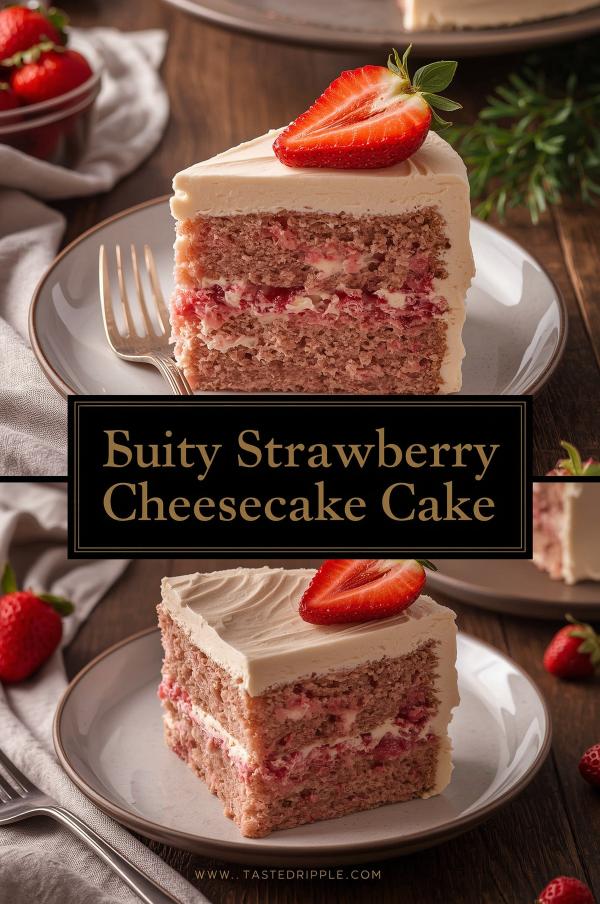Have you ever met a cake that made you stop mid-bite, tilt your head slightly, and think… well, this is something else? That’s the kind of reaction a strawberry cheesecake cake gets. It’s not just cake and it’s not just cheesecake—it’s both worlds mashed together, and somehow, they dance in harmony instead of fighting for attention.
I first stumbled across the idea years ago in a small bakery tucked down an alley in Florence. The baker—wrinkled hands dusted with flour, a grin that suggested secrets—slid a slice across the counter. Dense cheesecake sandwiched inside soft sponge, with strawberries bleeding their juices into the frosting. One forkful and I knew: this isn’t a simple dessert, this is an event.
What makes strawberry cheesecake cake special
It’s more than a novelty. Cheesecake alone can be heavy, rich to the point of silence on the table. Cake alone sometimes feels too fluffy, almost fleeting. But combine the two and you get balance—velvety cream cheese filling nestled inside tender layers of strawberry-scented cake. It’s indulgent without knocking you flat.
Strawberries, too, aren’t just tossed in for color. They cut through the creaminess with their acidity, and when baked or macerated, their sugars deepen into a fragrance that perfumes the whole slice. You smell it before you taste it. That’s why this recipe is adored by pastry chefs—it plays with texture, weight, acidity, and sweetness all at once.
Ingredients and substitutions
When making a hybrid cake like this, ingredients matter even more than usual. Each component—cake, cheesecake, frosting, strawberry filling—has to pull its weight.
Here’s a structured list to keep things tidy.
Ingredient Table
| Component | Ingredient | Measurement | Notes & Substitutions |
|---|---|---|---|
| Cake Layers | All-purpose flour | 2 ½ cups (320 g) | Can use cake flour for lighter crumb |
| Baking powder | 2 ½ tsp | Don’t swap with soda unless recipe is adjusted | |
| Salt | ½ tsp | Balances sweetness | |
| Unsalted butter (soft) | ¾ cup (170 g) | Margarine possible but flavor suffers | |
| Granulated sugar | 1 ¾ cups (350 g) | Can replace ¼ cup with brown sugar for depth | |
| Eggs | 4 large | Room temp for structure | |
| Whole milk | 1 cup (240 ml) | Buttermilk works for tangier note | |
| Fresh strawberries (pureed) | 1 cup (240 ml) | Frozen works if thawed & drained | |
| Cheesecake Layer | Cream cheese | 24 oz (675 g) | Must be full-fat; low-fat won’t set properly |
| Granulated sugar | 1 cup (200 g) | Adjust to taste | |
| Sour cream | 1 cup (240 g) | Greek yogurt works as lighter swap | |
| Eggs | 3 large | Adds richness and structure | |
| Vanilla extract | 2 tsp | Pure extract best | |
| Frosting | Cream cheese | 8 oz (225 g) | Full-fat only |
| Unsalted butter | ½ cup (115 g) | Soft but not melted | |
| Powdered sugar | 4 cups (480 g) | Adjust for consistency | |
| Strawberry jam or puree | ½ cup | Adds natural pink hue | |
| Strawberry Filling | Fresh strawberries (sliced) | 2 cups (300 g) | Macerate with sugar |
| Sugar | 2 tbsp | Pulls juices for syrupy effect | |
| Lemon juice | 1 tbsp | Keeps flavor bright |
One thing worth noting—don’t skimp on cream cheese quality. Cheaper versions often carry stabilizers that break down when baked, leaving a grainy filling. Go for blocks, not tubs, since tubs are whipped and hold more air, which weakens structure.
If strawberries aren’t in season, frozen can save the day. Just thaw fully and press out excess liquid, otherwise the cake turns soggy at the edges.
Step-by-step instructions
This recipe requires layering, chilling, and patience. It’s not a whip-and-go cake. But that’s the beauty—you feel involved with it, almost like building a sculpture.
1. Bake the cheesecake first
Line a springform pan with parchment, grease the sides, and pour in the cheesecake batter. Bake at 325°F (160°C) until set but still a little wobbly in the center—about 50 minutes. Cool completely, then chill at least 4 hours or overnight.
Pro tip: place a pan of hot water on the oven rack beneath to prevent cracks. Steam keeps the surface smooth.
2. Prepare the strawberry cake layers
Cream butter and sugar until pale and fluffy. This step traps air, giving lift. Add eggs one at a time, then fold in flour mixture and strawberry puree alternately with milk. Divide between two greased pans. Bake at 350°F (175°C) for 25–30 minutes.
Common mistake: overmixing once flour goes in. It toughens the crumb. Stop as soon as streaks vanish.
3. Macerate strawberries
Mix sliced berries with sugar and lemon juice. Let sit 20 minutes. The juices will pool at the bottom—don’t throw them away, they’ll drizzle between layers for extra punch.
4. Whip up the frosting
Beat butter and cream cheese until smooth. Gradually sift in powdered sugar (never dump at once unless you enjoy sugar storms). Blend in strawberry jam for both flavor and color. Adjust consistency with a spoon of cream if too thick.
5. Assemble the masterpiece
Level cakes if domed. Place one cake layer down, spread a thin swipe of frosting, then spoon a few macerated strawberries. Gently set the cheesecake layer on top. Add more strawberries and their juices. Top with second cake layer. Coat with crumb layer of frosting, chill 30 minutes, then frost smoothly.
Variation: For drama, add a glaze of melted strawberry jam dripping down the sides. Guests gasp, guaranteed.
Cooking techniques & science
There’s fascinating chemistry behind this dessert. Cheesecake is essentially a custard stabilized with eggs and cheese proteins. If baked too hot, those proteins tighten fast, squeezing out moisture and causing cracks. That’s why a low oven with steam works—it coaxes the proteins to set gently.
The cake layers, meanwhile, rely on the creaming method. Butter traps air bubbles when beaten with sugar, which then expand in the oven. That’s why butter temperature matters—too cold and it won’t whip, too warm and it collapses.
Strawberries bring pectin to the mix, which helps thicken fillings when heated. That’s partly why jam or puree integrates so well into frosting—it stabilizes texture while adding natural sweetness.
Storage and reheating
This isn’t a cake you leave on the counter. Keep it refrigerated, covered loosely so air doesn’t dry it out. It holds well for 3–4 days. Cheesecake benefits from a full chill anyway; flavors deepen after a night in the fridge.
Freezing works if wrapped tightly. Slice first, then wrap individual pieces. To serve, thaw overnight in the refrigerator. Never microwave—it ruins texture. Room temperature for 30 minutes before serving wakes up flavors.
Variations
- Gluten-free: Substitute a good blend with xanthan gum. Avoid almond flour, too oily for sponge structure.
- Vegan twist: Tricky, but possible with cashew-based cheesecake filling and aquafaba as egg replacer. Cakes can use flax eggs. Frosting swaps with vegan butter and cashew cream.
- Chocolate version: Swap ½ cup flour for cocoa powder in cake layers, and add chocolate ganache drip. Strawberries plus chocolate never argue.
- Mini cakes: Bake cupcakes with cheesecake dollops inside for handheld versions.
Tools worth mentioning
- A springform pan is non-negotiable for cheesecake. Otherwise removal is chaos.
- A serrated knife works best for slicing clean layers. Wipe between cuts for neat presentation.
- Stand mixer saves your wrists. Hand mixers work but take longer to cream butter properly.
Serving and pairing suggestions
Presentation matters with this cake. A simple slice already looks layered and dramatic, but you can elevate it further. Scatter fresh strawberry halves around the plate, drizzle with macerated juices, maybe add a dollop of whipped cream dusted with crushed freeze-dried strawberries.
For drinks, coffee balances richness, but champagne with a hint of fruit makes it celebratory. A dry rosé works surprisingly well too, echoing the strawberry while cutting the cream.
As for side pairings—keep them light. A fresh green salad before dessert, or no side at all. The cake is center stage, not background.
Best time to serve
This isn’t an everyday cake, though I wouldn’t judge if someone tried. It shines at celebrations—birthdays, anniversaries, Valentine’s dinners. Spring and summer especially, when strawberries are at peak. Bring it out at the end of a long outdoor lunch and watch faces light up.
It also works in winter if you lean on jam or frozen fruit, but the mood feels different. More nostalgic, less vibrant. Either way, it’s always received with a hush followed by sighs.
Conclusion
Strawberry cheesecake cake isn’t just dessert. It’s craftsmanship—layers working together, each chosen for contrast and balance. The sponge cushions, the cheesecake grounds, the strawberries brighten, the frosting ties it all.
The secret isn’t in rushing but in respecting each part. Chill the cheesecake. Cream butter patiently. Slice strawberries with care. These details are what transform it from good to unforgettable.
And remember, not all cakes ask for applause when sliced. This one does.
FAQs
Can I make the cheesecake and cake layers ahead of time?
Yes. Bake cheesecake up to 2 days before, keep chilled. Cake layers can be baked 1 day ahead and wrapped tightly. Assemble fresh for best texture.
My cheesecake cracked—will it ruin the cake?
Not at all. Since it’s sandwiched between layers, cracks disappear. But to avoid them, use steam and don’t overbake.
Can I reduce the sugar?
A little, yes. Remove up to 20% without major issues. Beyond that, structure and moisture suffer, especially in cake layers.
Do I have to macerate the strawberries?
Highly recommended. It intensifies flavor and adds natural syrup. Without it, berries can taste flat.
What’s the best knife for slicing?
A long serrated bread knife works best. Heat the blade briefly under hot water, dry it, then cut. It glides clean without dragging.
This article reaches beyond the recipe—it digs into science, technique, and artistry of strawberry cheesecake cake. Each forkful tells you why it matters: because no single dessert should carry every emotion, but this one nearly does.
Would you like me to also create a nutritional breakdown table for this cake (calories, macros per slice) so professionals can better analyze its profile?

